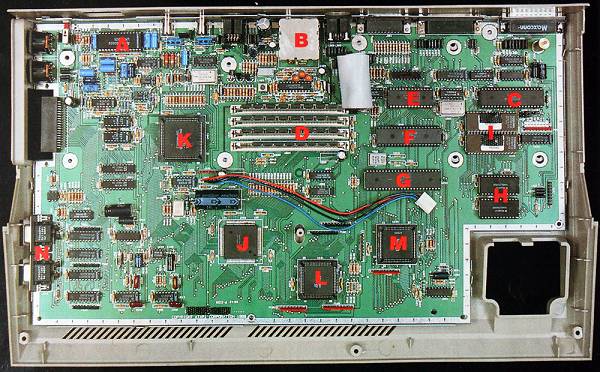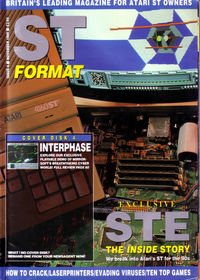
Boasting better sound and graphics, new game controller ports and hard- ware scrolling, the STE also maintains ST compatibility.
If Germany seems an odd place for an American computer giant to launch a new machine, remember that it has an ST user base estimated at 600,000 - the largest in the world. By launching there, Atari can accurately gauge the world's reception.
Atari UK, meanwhile, is playing down the STE, calling it simply the next step in the ST's ever-evolving design - just as double-sided drives have become standard in 520s and TV modulators are built into 1040s.
Indeed, judging by the tiny E on the box, Atari really isn't too keen to shout about the new machine.
Why? Because the computer isn't there yet. Because all the shouting has been done already. Because it doesn't live up to unrealistic expectations. Because there are heaps of standard STs to sell.
Nevertheless, the STE is going to become the standard. Not today, but certainly next year.
(Goldrunner, Return to Genesis)
''The prospect of the STE doesn't excite me: I won't even look at the machine until Atari has sold several thousand units.
"The problem Is that the ST Is so well established that it's going to take some spectacular marketing to get the STE noticed.
''When, and If, It does become a moderate success the problems will only just start. Developers will have to write two versions of the same program - three If you count the Amiga."
To date very few programming teams have STE development kits, so unless something unexpected or unannounced occurs, it's unlikely the machine or any soft- ware will be widely available until next year. (We can't tell you where we found ours!)
The final UK configuration hasn't even been finalized: but if Gleadow doesn't change his mind again, a 1040STE with 1Mbyte of memory will come first, followed later by a 520STE. Price for the new 1Mbyte machine will be £499 - the same as the existing 1040 it will eventually replace.
SAME AS IT NEVER WAS
Shiraz Shivji's original ST design has taken some serious pummeling over the years. In its first incarnation the ST appeared in several bits. Eventually everything came together in the now familiar box. Minor internal modifications - cost-cutting exercises, mostly - continually occur. Although Shivji didn't complete work on the STE, having moved on to Tandon, he started fiddling with the machine almost two years ago.
Externally the STE differs little from its predecessor. Look hard and you notice two new game controllers on the left side and stereo phono sockets at the back. Apart from that: all ports are identical.
Inside, things are radically differ- ent. Briefly, Shifter has disappeared (swallowed by the memory management unit); the Blitter Is present as standard; there's a new chip for handling tone and volume levels; the 68000 processor is - bizarrely - square rather than oblong; and finally, memory comes on neat plug-in boards.
Phono sockets are located at the back of the machine, and simply offer left and right channel sound output. An amplifier and speakers can be plugged into these sockets for reproducing stereo sound. Both the YM2149 and DMA sound can be output simultaneously through these sockets.
There are two new 15-pin game controller pods on the right side of the computer, just below the MIDI sockets and cartridge slot. Two joysticks can be fitted to each new controller (adaptor required). Paddles can also be plugged into both controllers.
A light gun or light pen can be inserted into the first of the controller ports. The cursor position in the X axis can accurately be measured to within four pixels in 320 by 200 mode, eight pixels in 640 by 200 mode and 16 pixels in 640 by 400 mode. Pixel accuracy is possible in the Y direction.

• The pinout for the first port (from right to left and top to bottom): 1, up 0; 2, down 0; 3, left 0; 4, right 0; 5, paddle Y; 6, fire 0; 7, VCC; 8, not connected; 9, ground; 10, fire 2; 11, up 2; 12, down 2; 13, left 2; 14, right 2; 15, paddle X. The second port looks after sticks one and three.
The STE (below) has RS232, printer, DMA, second floppy, modulator and monitor ports in the same locations as the ST


The simple way of discovering which version of TOS your
machine has: click on Desktop Info in the Desk menu.
TOS 1.6 boasts a pretty rippling Atari symbol and new
copyright dates

Compare the existing circuitry of the 1040STFM with the
STE's layout below. Notice the STE only has four custom
chips: DMA, MMU, Blitter and Glue. Although the Blitter
isn't present on the ST, there is room for it. And where
has the Shifter goneon the STE?
A The LMC1992 volume and tone control chip, a new addition to the standard ST circuit board. The chip alters volume and tone settings in steps of 2dB, and determines whether the YM2149 sound output is mixed with the output from the DAC
B The modulator in this box allows you to connect STE to TV
C All DMA (direct memory access) operations are handled by the DMA controller. This 40-pin chip oversees the floppy drive controller, hard drive, laser printer and all other DMA devices. It also looks after PCM (pulse code modulated) sound generation
D Memory comes on small plug-in boards, each offering 1 Mbte of memory and coming with eight 1 Mbit DRAMs. Up to four can be fitted. It's likely that the STE will come in two con figurations: 1 Mbyte and 4Mbytes (the model shown here)
E The WD 1772 floppy disk controller provides low-level access to the STE's double- sided 2.5-inch floppy drive. It controls the drive motor, reports on the write-protect status, and reads/writes data
F Yamaha's YM2149 sound generator maintains inter-ST compatibility. It offers three independently programmable tone generators, a programmable noise generator, completely software controlled analogue output, programmable mixer for tone and noises, 15 logarithmically raised volume levels, and programmable envelopes
G The hardworking 68901 MFP (multi-function peripheral) offers 8-bit parallel port; programmable data direction of every port; 16 possible interrupt inputs, four universal timers; and serial interface

H There are two 6850 ACIAs (asynchronous communications interface adaptor). The 6850 talks to serial devices and ensures data flow. One chip communicates with the intelligent keyboard, mouse, and joystick ports, while the other operates the MIDI interface
I All 192K of the STE's operating system (GEM, TOS in a new version - see overleaf - and so on) is kept on these two ROMs
J What on earth has Atari done to this chip? The ST's MMU (memory management unit) has 68 pins - here it's more than 100! Two things suggest this custom chip now houses the graphics chip shifter: extra pins, and the fact that the original MMU worked closely with Shifter to produce the video signal. The new MMU also looks after the coupling of the dynamic RAM with the processor's bus and the DMA's addressing
K The Glue chip is the most important IC of the four custom chips, literally holding the system together. Among its many talents, Glue decodes the address range, produces the DMA handshake signals, generates the interrupt signal, and generates timing frequencies of 8mHz and 500kHz
L The Blitter (bit block transfer professor), standard in the STE, operates automatically on certain A-line and VDI functions, providing considerable increases in the speed at which blocks of memory can be manipulated. The Blitter can be used to provide rapid implementations of the following: area fills, rotations and magnifications, line drawing, text transformations, text scrolling window updating, pattern fills, block copying
M surprise! The Motorola 68000 processor is no longer oblong, but rather square, like other members of the 68K series. It works the same, though
N Two new game controllers, allowing up to six joysticks. The 15-pin adaptors can also accept paddles and light gun or pen
LIKE A VERSION: TOS UP
What with all these internal modifications, Atari has had no choice but to include a new version of TOS. Version 1.6 follows on from the yet-to-be-released 1.4.
From a WIMP user's point of view there are no differences between 1.4 and 1.6 - except the alert box produced by clicking on Desktop Info in 1.6 is a pretty Atari symbol (big deal). Deep down, though, the new TOS looks after the extended palette, hardware scrolling and DMA sound.
(Blood Money)
Its really not very exciting - at least not to me. The hardware scrolling is nice, but while it will be useful for some games, others will probably benefit from software scrolling. If you've got lots of sprites moving about, the advantages of hardware scrolling will be can- celled out.
''The Blitter is a complete waste of time and space. It's the same affair that graces Mega STs. No barrel shifting equates to 'Don't bother using me.'
"It's highly unlikely I'll be developing anything for it - certainly not to start with any- way. It depends how many Atari sell."

Here's what TOS version 1.4 and the STE'S 1.6 have that your version of the operating system doesn't:
• Rather than typing in the drive path in the file selector, you can simply click on a drive letter icon;
• You can rename folders by high- Iighting them and clicking on
Show Info;
• A better disk copy process reduces the number of disk swaps required on a single floppy machine. Disk access in general has been greatly improved;
• Files can be moved from one directory, or disk, to another
• The machine can be reset by holding down Control, Alternate and Delete (PC users will recognize that combination);
• IBM PC disks can be formatted;
• Finally, Undo aborts any printing, copying, deleting or moving operations.
COME THE RESOLUTION
From a programming perspective, new graphics registers have been provided by the MMU/Shifter, making it possible to achieve bit-wise scrolling and vertical screen splits.
Scrolling can take place horizontally or vertically a pixel at a time. And, being hardware based, it is damn fast.
Some video registers can be tampered with to split the screen vertically into multiple independent scrolling regions. A single screen doesn't have to be a contiguous block of storage, but could be composed of numerous strips held in memory in any order.
The same data could be repeated on one or more display lines. A screen area could have its own data and scrolling direction.
The STE's palette has been increased from 512 to 4,096 colours. The method is fiendishly Clever, and ensures Complete compatibility with the ST's video modes. The fourth bit of palette resolution has been added above the old most significant bit.
Contrary to reports, there are no other graphic modifications. The STE has exactly the same resolutions, and is allowed an identical number of colours On Screen, as the ST: 320 by 200 in 16 colours, 640 by 200 in four colours, 640 by 400 in black and white.
(Starglider II, Afterburner)
''Graphically it's not leaps and bounds better. The Amiga's had hardware scrolling for five years - and few people use it.
It's just too memory wasteful to store complete screens in memory. Scrolling is possible without scroll registers.
''Really the point has been missed: it's all very well having extra colours, but what's the use if you can't display more on screen?
''Stereo sound has been extremely lousily implemented.Only a few fixed sample rates are possible. Maths-intensive software routines will have to be applied to sample data if other frequencies are wanted.
''And six joysticks? Who's going to write a game in which six are used? it'd make a great Gauntlet engine!"

(Blood Money)
''Upgrading an ST to an STE? No chance. Too much has altered internally. The Shifter chip has disappeared altogether - it looks as though It's been incorporated into the MMU chip.
"And heavens knows what they've done to the Glue - it's also a lot bigger. There's also a new tone/volume controller chip on the board. On top of all that there are stereo phono sound jacks and two new-style game controllers. Introducing all that into an ST would be a nightmare. Too costly.
''I'm surprised Atari has kept the standard joystick and mouse ports in the annoying location underneath the unit. There's plenty of room on either the left or right side of the machine. I guess it was just down to cost.
"Most of the important chips - apart from the one that usually dies first, the MMU - have been socketed. I hope Atari keeps it that way - It makes my life easier!"
SOUND: ABOUT RIGHT
The STE is equipped to reproduce digitized sound using DMA (direct memory access) - that is, without the 68000's involvement. To retain ST compatibility, the STE also comes with a YM2149 sound generator.
DMA sound is stored in memory as 8-bit samples. The DMA sound chip fetches samples from memory and provides them to a digital-to-analogue (DAC) converter at one of four constant rates between 6.25 and 50kHz.
The output of the DAC is filtered to a frequency equal to 40% of the sample frequency by a four- pole switched low-pass filter. This performs anti-aliasing (smoothing) of the sample data.
The signal is further filtered by a two-pole fixed frequency (16kHz) low-pass filter before being passed to a National LMC1992 volume and tone controller. Finally, the sound is sent to a phono output at the back of the computer.
Two channels, behaving as described above, are available. These are the left and right channels of a stereo system. The stereo sound can be mixed with the YM2149's output before being sent to the monitor's speaker and phono sockets.
The LMC1992, an off-the-shelf chip common in TV sets, provides volume and tone control- both can be attenuated in 2dB steps. Its jobs include setting the master volume, altering left and right volumes individually, defining treble and bass separately, and determining whether or not YM2149 and DMA sound is mixed.
All in all - as is clear from the programmers talked to - the verdict must be that this is not a radical rewrite of the ST's specification. In a sense that's not a bad thing, because very soon - within a year, I'd guess - it will replace the 1040ST.



